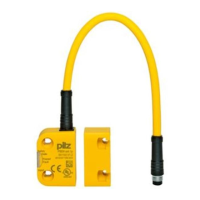
Do you have a question about the Pilz PSEN cs3.1a and is the answer not in the manual?
| Type | Safety switch |
|---|---|
| Operating Voltage | 24 VDC |
| Number of Safe Outputs | 2 |
| Protection Type | IP67 |
| Safety Category | Cat. 4 |
| Standards | EN ISO 13849-1, EN IEC 60947-5-3 |
| Housing Material | Plastic |
| Connection Type | M12, 8-pin |
| Mechanical Life | 10 million operations |
How to use the manual and understand its symbols and warnings.
Information on which product versions the documentation is valid for.
Specifies the intended application and compliance with safety standards like EN 60947-5-3.
Covers safety regulations, assessment requirements, and the need for qualified personnel.
Details warranty terms, proper disposal methods, and critical safety warnings.
Highlights transponder technology, coding, dual-channel operation, safety inputs/outputs.
Details SDD capabilities, diagnostic inputs, and outputs for enhanced monitoring.
Describes LED status indicators and available connection types for the unit.
Explains the basic function, electrical states of inputs/outputs, and safe conditions.
Details input plausibility checks and how unequal input statuses are displayed.
Explains the function of diagnostic input Y1 and signal output Y32.
Visual representation of the safety switch's internal connections and components.
Describes diagnostic options for fieldbus modules and simple wiring configurations.
Defines assured and typical operating/release distances for actuator detection.
Specifies the maximum permitted lateral and vertical offsets for installation.
Outlines essential wiring practices, voltage requirements, and EMC considerations.
Details requirements for safety relays, voltage supply, and fuse protection.
Addresses manipulation protection and upstream device control in series configurations.
Details pin assignments for cables and required properties of evaluation devices.
Provides important cautions regarding signal output connections to prevent damage.
Illustrates the wiring diagram for a single connection without Safety Device Diagnostics.
Illustrates the wiring diagram for a single connection utilizing Safety Device Diagnostics.
Explains suitability for series connection and the impact on delay-on de-energisation time.
Lists approved passive junctions for creating series connections with SDD.
Displays the wiring diagram for multiple safety switches connected in series without SDD.
Displays the wiring diagram for multiple safety switches connected in series with SDD.
Lists suitable Pilz evaluation devices for safety gate monitoring applications.
Provides wiring examples for connecting to PNOZ s3 and PNOZmulti evaluation devices.
Covers how the actuator is taught and general installation principles.
Important notes on torque, distances, avoiding end-stop use, and bending radii.
Step-by-step guide for mounting the safety switch using M4 screws.
Steps for attaching actuators CS1.1 and CS3.1 with M4 screws.
Illustrates parallel and orthogonal assembly of switch and actuator.
Warns about environmental factors affecting manipulation protection for low profile actuators.
Covers sealing, actuator removal, and adhesive force considerations for low profile actuators.
Detailed steps for cleaning and preparing surfaces for adhesive actuator attachment.
Steps for attaching the actuator using adhesive, including foil removal and pressing.
Information on achieving and checking the adhesive force after mounting.
Steps for preparing surfaces and using the assembly aid for screw mounting.
Guide for inserting and positioning the screw for low profile actuator mounting.
Steps for checking adhesive force and tightening the mounting screw to specification.
Procedures for aligning the safety switch and actuator and securing them.
Explains how operating distances apply and how offsets might affect them.
Important notices regarding safety function checks after commissioning or changes.
Explains the meaning of LED indicators for readiness, safety gate status, and faults.
Provides detailed measurements for the safety switch unit.
Displays dimensional drawings for PSEN cs1.1 and PSEN cs3.1 actuators.
Shows dimensional details for the PSEN cs3.1 low profile glue actuator.
Displays dimensional details for the PSEN cs3.1 low profile screw actuator.
Covers certifications, operating modes, coding, supply voltage, and switching frequencies.
Details input ranges, cable resistance, OSSD outputs, and switching capacities.
Provides data on output types, timing parameters, and risk time.
Specifies operating temperatures, humidity, EMC compliance, and vibration resistance.
Details airgap creepage, overvoltage category, pollution degree, and insulation voltage.
Lists assured and typical operating distances for Actuators 1 and 2.
Lists operating distances for Actuators 3 and 4, and mechanical data.
Covers bending radii, cable diameter, max torque, dimensions, and weight.
Consolidates transponder frequency and environmental data for various models.
Details mechanical data, dimensions, and weight for different actuator models.
Provides environmental limits, EMC compliance, and mechanical properties for specific models.
Describes classes and parameters for input interfaces (Drain).
Details classes and parameters for single-pole output interfaces (Source).
Presents SIL/PL values, PFH, PFD, and mission time according to safety standards.
Explains safety data and recommends using the PAScal software tool for calculations.
Details FCC and IC compliance for radio frequency operation.
Lists order numbers for different safety switch and actuator models.
Provides order numbers for complete safety gate systems.
Lists order numbers for installation accessories and various cable types.
Lists order numbers for junctions and connectors used in series connections.
Details order numbers for fieldbus modules used with Safety Device Diagnostics.
Lists directives met by the product and where to find the full declaration.
Identifies the official representative for the product.
Provides contact phone numbers for technical support worldwide.
Highlights Pilz's commitment to sustainability, energy saving, and quality certifications.